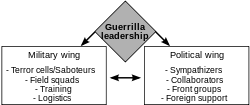People's war
In its original formulation by Chairman Mao Zedong, people's war exploits the few advantages that a small revolutionary movement has—broad-based popular support can be one of them—against a state's power with a large, professional, well-equipped and well-funded army.[citation needed] In phase one, the revolutionary force conducting people's war starts in a remote area with mountainous or forested terrain in which its enemy is weak.[citation needed] Historian David Priestland dates the beginning of the policy of people's war to the publication of a "General Outline for Military Work" in May 1928, by Chinese Central Committee.[3] As sociologist Alessandro Russo summarizes, the political existence of peasants via the PLA was a radical exception to the rules of Chinese society and "overturned the strict traditional hierarchies in unprecedented forms of egalitarianism.He instructed his subordinated to “Take this crackdown as the top project,” and “to preempt the enemy, to strike at the outset.” Following a meeting with Xi in Beijing Chen Quanguo held a rally in Ürümqi with ten thousand troops, helicopters, and armored vehicles.

Simplified ChineseTraditional ChineseStandard MandarinHanyu PinyinWade–Gilesother MandarinXiao'erjingYue: CantoneseYale RomanizationMaoismAgrarian socialismAntagonistic contradictionAnti-imperialismAnti-revisionismCapitalist roaderCompradorContinuous revolution theoryCultural RevolutionFour OldsMarxism–LeninismMass lineNewborn socialist thingsNew DemocracyOne Divides into TwoProbable defeatRevolutionary base areaSeek truth from factsSelf-criticismSocial imperialismThree Worlds TheoryMaoism–Third WorldismMao-spontexMarxism–Leninism–MaoismGonzalo ThoughtPrachanda PathMao ZedongFaiz AhmadLouis AlthusserSamir AminBob AvakianAlain BadiouMohan BaidyaAfzal BangashCharles BettelheimBiplavBo XilaiChen BodaChin PengPushpa Kamal DahalSaroj DuttaNorm GallagherAbimael GuzmánHarry HaywoodTed HillGeorge Jacksonİbrahim KaypakkayaJiang QingKang ShengLi MinqiLin BiaoCharu MajumdarPierre MuleleHuey P. NewtonNie YuanziQi BenyuMuppala Lakshmana RaoNarayan SanyalSiraj SikderJose Maria SisonWang HongwenYao WenyuanAkram YariZhang ChunqiaoReport on an Investigation of the PeasantMovement in HunanOn ContradictionOn PracticeOn Guerrilla WarfareOn Protracted WarOn the Ten Major RelationshipsOn the Correct Handling of ContradictionsAmong the PeopleA Critique of Soviet EconomicsQuotations from Chairman Mao Tse-tungHistoric Eight DocumentsBombard the HeadquartersChinese Soviet RepublicJiangxi SovietLong MarchChinese Communist RevolutionPeople's Republic of China1949–19761976–19891989–20022002–presentCampaign to Suppress CounterrevolutionariesKorean WarSino-Soviet splitGreat Leap ForwardBlack Power movement16 May NotificationRed AugustJanuary StormDown to the Countryside MovementNew Communist movementCambodian Civil WarNaxalite–Maoist insurgencyNaxalbari uprisingNew People's Army rebellionSino-Albanian splitMaoist insurgency in TurkeyDeath and funeral of MaoCambodian–Vietnamese WarTwo WhateversInternal conflict in PeruNepalese Civil WarChongqing modelChinese Communist PartyCommunist Party of Peru – Shining PathNational Democratic Front of the PhilippinesCommunist Party of the PhilippinesNew People's ArmyCommunist Party of Turkey/Marxist–LeninistCommunist Party of Nepal (Maoist Centre)Communist Party of India (Maoist)Purba Banglar Sarbahara PartyCommunist Party of BurmaCommunist Party of Ecuador – Red Sun